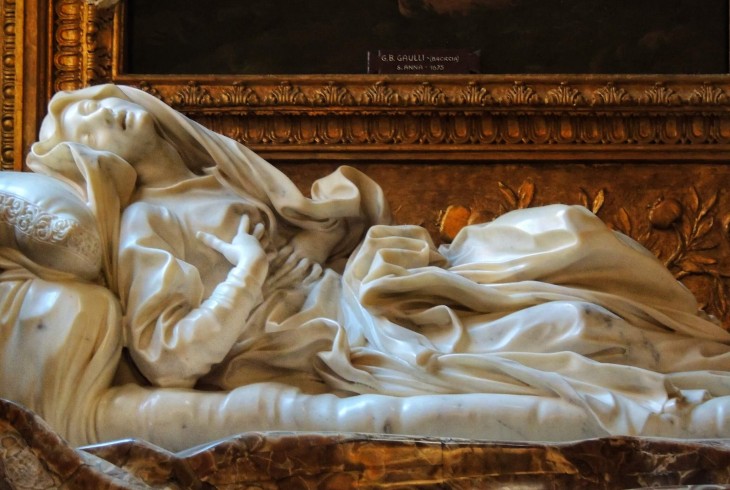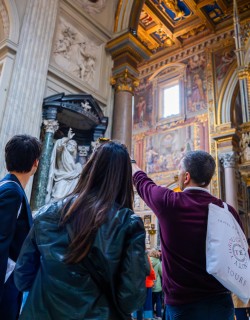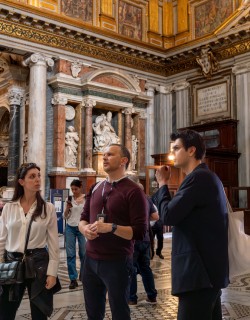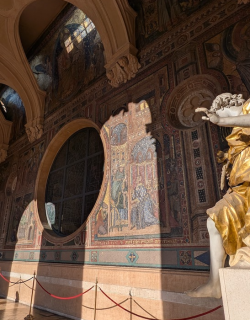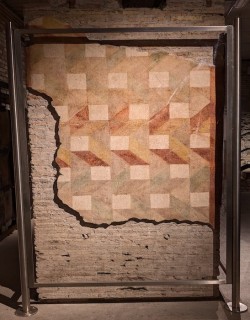She lies on the cusp between two worlds, forever stilled in the eternalised moment of her final breath. Hand clutching at her failing heart, lips parted in a sigh that will take her to the great unknown of the afterlife, the blessed Ludovica Albertoni is is propped up upon a cushion whose plump creases belie the material reality of its unyielding marble. After a lifetime of caring for the poor and sick of the Eternal City, Ludovica was poised to reap her heavenly award.
Ludovica Albertoni’s story is a classic tale of female piety in Renaissance Italy. Born into an aristocratic family in 1473, the young noblewoman was widowed in her early 30s and decided to devote herself to a life of Christian charity and good works. Joining the Franciscan community at the church of San Francesco a Ripa in Trastevere, Ludovica quickly gained a reputation as a tireless advocate of the city’s disadvantaged and destitute. During the brutal 1527 Sack of Rome and its horrifying aftermath she provided succour to the city’s wounded and displaced masses, earning her the nickname ‘the mother of the poor’ by concealing gold coins in the bread she distributed to the desperate denizens of Trastevere.
Adding further lustre to her status as an exceptionally holy woman, Ludovica was also reputed to levitate during ecstasies of prayer, and engaged in mystical communions with the divine power. Little wonder, then, that after her death from fever and burial in in San Francesco a Ripa in 1533 she was immediately venerated as a saint in her local Trastevere. The cult of her devotion would have to wait 140 years for official recognition, however.
 The church of San Francesco a Ripa, site of Ludovica Albertoni's burial
The church of San Francesco a Ripa, site of Ludovica Albertoni's burial
As so often with these things, it was a shift in the political winds that led to Ludovica’s beatification. A nephew of her descendent Cardinal Paluzzo Paluzzi degli Albertoni had the great good fortune to marry Pope Clement X Altieri’s niece, and in return the newly elected Pope adopted Paluzzo as his own nephew - transforming him at a stroke into one of Rome’s most powerful men.
Naturally the thoughts of Paluzzo (who had taken to calling himself Cardinal Altieri in recognition of his newfound status) quickly turned towards burnishing the family reputation, and he had little trouble convincing his adoptive uncle to elevate his pious ancestor. Ludovica was beatified in an extravagant ceremony at St. Peter’s basilica in 1671, and Paluzzo set about embellishing the humble chapel that housed Ludovica’s earthly remains. The centrepiece of the renovated chapel was to be a larger-than-life-sized sculpture of the saint herself, caught in the throes of one of the religious ecstasies for which she had become famous.
Casting about for an artist with the expressive capabilities to do justice to the memory of a figure whose life was characterised by frequent mystic communion with God, there was really only one choice. Over the past several decades, Gianlorenzo Bernini had established himself as the pre-eminent artist of the age, doing much to shape the extravagant form of Baroque art as we know it today. What was more, Bernini had already shown himself able to transform the mystery of religious ecstasy into material form in a way that has perhaps never been matched by an artist before or since.
Bernini’s much earlier sculpture of the Ecstasy of St. Teresa in the Cornaro Chapel in Rome’s Santa Maria della Vittoria had set a new standard for representing the ineffable moment of human contact with the divine: there the Spanish mystic floats on a marble cloud high above the chapel floor as an angel plunges an arrow into her heart, causing her to moan in a moment of religious (and arguably sexualised) ecstasy. The work caused a scandal, but was also wildly popular. No doubt Cardinal Albertoni hoped Bernini could recapture the magic that had coursed through his chisel over 20 years earlier. And, as luck would have it, the aged master owed the Pope a favour.
A devout but tempestuous and passionate man, Bernini’s long life was never too far from controversy. The sculptor’s torrid love affair with the married Costanza Bonarelli back in the 1630s was the stuff of legend, a tale of passion, sex and violence. When Gianlorenzo discovered that his mistress was also involved with his own brother Luigi, Bernini broke two of his ribs with an iron bar; Luigi managed to to take refuge in Santa Maria Maggiore before skipping town. What was worse, the jealous sculptor sent an accomplice to exact violent revenge on Costanza, who suffered a slashed face as a result. An extraordinary and passionate portrait of Costanza sculpted by Bernini at the height of their torrid affair speaks vividly of the young artist’s violent passion.
For his part, Luigi was forced to remain in exile for a few years. But, proving blood is thicker than water, he was eventually reconciled with his brother and collaborated with him frequently over the following decades. By the time the time the 1670s rolled around, the venerable Gianlorenzo was no longer the firebrand of his youth - but Luigi’s behaviour went from bad to worse. Making good use of the family connection, Luigi had managed to get himself put in charge of reconstructing the Sala Regia in the Vatican, where Gianlorenzo was busily working on his equestrian portrait of the emperor Constantine. It wasn’t to end well.
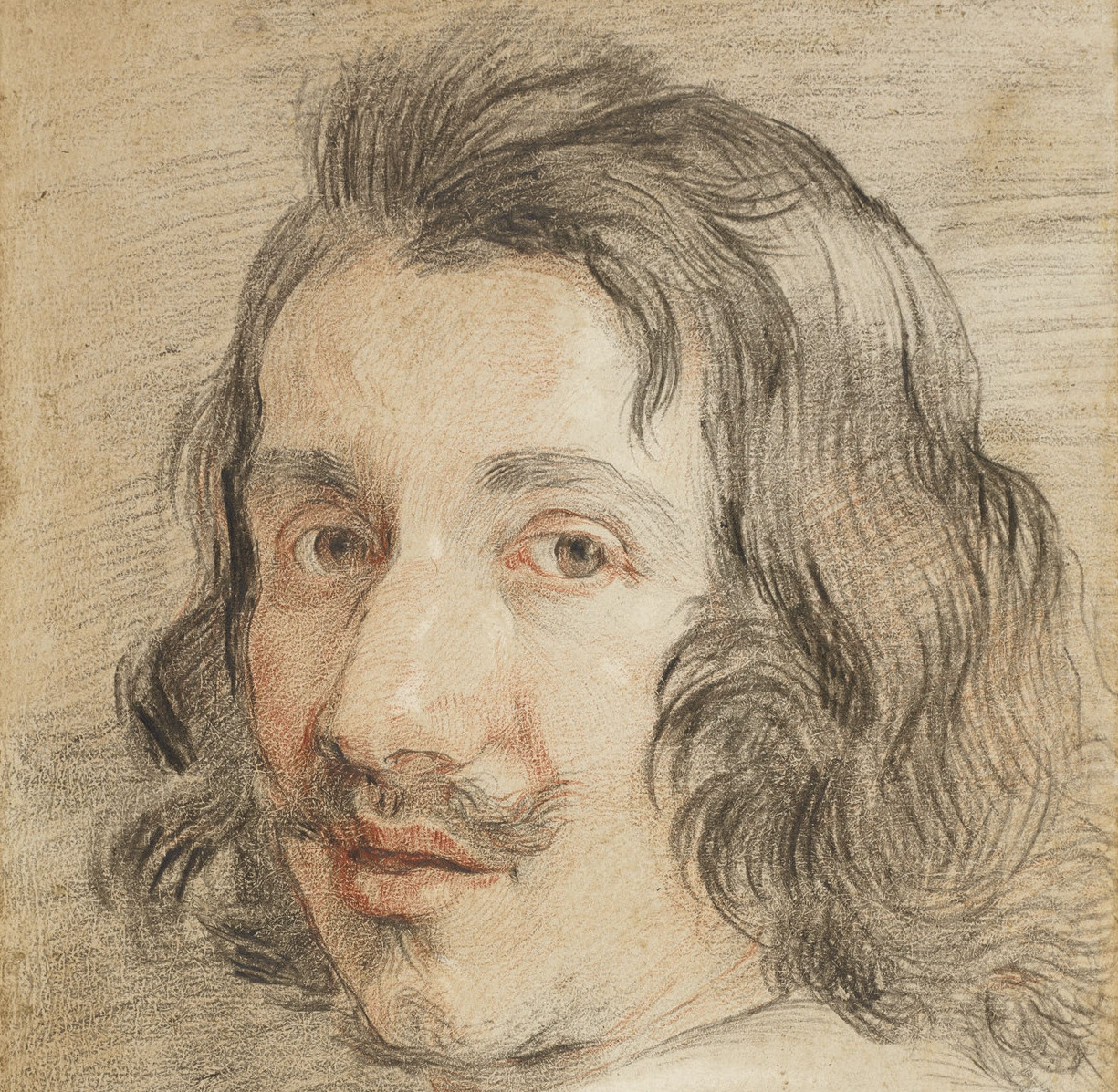 Gianlorenzo Bernini, Portrait of Luigi Bernini © Royal Collection Trust
Gianlorenzo Bernini, Portrait of Luigi Bernini © Royal Collection Trust
In the gloomy shadows of the building site, Luigi was to commit a terrible crime. Unleashing a brutal sexual assault one of the boys hired to help out on the works, Luigi reportedly left his victim with 16 broken bones. It was left to Gianlorenzo to pick up the pieces and salvage the family honour. Luigi fled to Naples in order to escape justice, whilst Gianlorenzo did everything in his power to smooth over the scandal.
Bernini’s influence with the Roman elite was, for once, proving insufficient to securing his brother’s pardon. Cardinal Albertoni, who was the real power behind the papal throne, had taken an uncompromising stance against forgiving Luigi for his wicked crimes. And so, ever the wily operator, Gianlorenzo offered him the one thing that he was powerless to resist: in addition to paying reparations to the family of the victim as well as an eye-watering fine, Gianlorenzo agreed to carry out the restorations to the chapel of the Pope’s adoptive nephew free of charge. Albertoni was going to get his sculpture, and he was going to get it gratis.
 The Albertoni Chapel in San Francesco a Ripa
The Albertoni Chapel in San Francesco a Ripa
The aged master pulled out all the stops in order to please the Papal nephew, following the compositional principles that had brought him so much success in his earlier depiction of a swooning mystic in the Cornaro Chapel. Bringing together sculpture, architecture and painting in a meticulously orchestrated and unified ensemble, the Albertoni Chapel is a perfect exemplification of Bernini’s theory of the ‘bel composto.’ On the chapel’s altar wall, a painting by renowned Baroque artist Baccicio depicts Virgin and Child with St. Anne in a bucolic pastoral landscape, providing a backdrop for the rest of the ensemble. The chapel appears deeper than it is thanks to a telescoping effect created by Bernini’s used of angled walls and the central arch, focusing the viewer’s attention entirely on the chapel’s centrepiece, the recumbent statue of the Blessed Ludovica herself. And what a centrepiece it is.
 Detail of Bernini's Ecstasy of the Blessed Ludovica Albertoni
Detail of Bernini's Ecstasy of the Blessed Ludovica Albertoni
Lying back on her deathbed, Ludovica’s head is thrown backwards in a paroxysm of both agony and ecstasy, eyes rolling wildly upwards. Her garments are a swirling and tumultuous rush of fabric and folds, seemingly agitated by the mysterious power of an unseen force, drapery taking on the kind of purely expressionist significance that had become such a hallmark of Bernini’s work ever since the stunning success of the Teresa. But it is the extraordinary beauty of Ludovica herself, and the amazing quality of the carving, that makes the sculpture unforgettable.
Despite his advanced years, Bernini carried out almost all of the carving of the Ludovica personally, delegating little if anything to studio assistants. And it shows. The subtly undulating features of Ludovica’s face are nothing short of captivating; despite the brilliant white sheen of the marble, the expiring beata seems made of flesh and blood, and the contrast between the frailty of her body wreathed in those voluminous draperies with the spiritual profundity of her heaven-bound expression speaks more profoundly of her spiritual state than any hagiography ever could. As ever, Bernini’s sculpture is a direct window deep into the recesses of the human soul.

When the sculpture was completed in 1674, it was immediately hailed as one of the greatest sculptural masterpieces of the age. Keeping up his end of the sordid bargain, Cardinal Albertoni ensured that brother Luigi was forgiven for his crimes, his confiscated properties restored and the way paved for his return from exile. Bernini’s son Pier Luigi meanwhile was rewarded with an important position in the Roman bureaucracy, whilst Gianlorenzo himself had to be content with reminding the world that age is no barrier to genius.
Although Bernini was already well into his 70s by the time he put chisel to marble in the artistic quest for what would turn out to be his final masterpiece, the virtuosity of the carving, the sureness of composition, line and form make clear that this is no final, wavering full stop at the twilight of a glittering career. On the contrary, the Blessed Ludovica might just be the summa of his creative philosophy, and the zenith of the sculptor’s achievements. Next time you are in Rome, make sure to visit the church of San Francesco a Ripa to see the Blessed Ludovica in all her glory!
